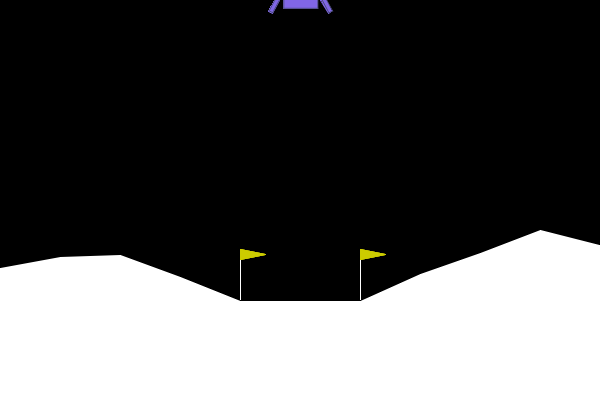Lunar Lander#

This environment is part of the Box2D environments.Please read that page first for general information.
Action Space |
Discrete(4) |
Observation Shape |
(8,) |
Observation High |
[1.5 1.5 5. 5. 3.14 5. 1. 1. ] |
Observation Low |
[-1.5 -1.5 -5. -5. -3.14 -5. -0. -0. ] |
Import |
|
Description#
This environment is a classic rocket trajectory optimization problem. According to Pontryagin’s maximum principle, it is optimal to fire the engine at full throttle or turn it off. This is the reason why this environment has discrete actions: engine on or off.
There are two environment versions: discrete or continuous. The landing pad is always at coordinates (0,0). The coordinates are the first two numbers in the state vector. Landing outside of the landing pad is possible. Fuel is infinite, so an agent can learn to fly and then land on its first attempt.
To see a heuristic landing, run:
python gymnasium/envs/box2d/lunar_lander.py
Action Space#
There are four discrete actions available: do nothing, fire left orientation engine, fire main engine, fire right orientation engine.
Observation Space#
The state is an 8-dimensional vector: the coordinates of the lander in x & y, its linear
velocities in x & y, its angle, its angular velocity, and two booleans
that represent whether each leg is in contact with the ground or not.
Rewards#
After every step a reward is granted. The total reward of an episode is the sum of the rewards for all the steps within that episode.
For each step, the reward:
is increased/decreased the closer/further the lander is to the landing pad.
is increased/decreased the slower/faster the lander is moving.
is decreased the more the lander is tilted (angle not horizontal).
is increased by 10 points for each leg that is in contact with the ground.
is decreased by 0.03 points each frame a side engine is firing.
is decreased by 0.3 points each frame the main engine is firing.
The episode receive an additional reward of -100 or +100 points for crashing or landing safely respectively.
An episode is considered a solution if it scores at least 200 points.
Starting State#
The lander starts at the top center of the viewport with a random initial force applied to its center of mass.
Episode Termination#
The episode finishes if:
the lander crashes (the lander body gets in contact with the moon);
the lander gets outside of the viewport (
xcoordinate is greater than 1);the lander is not awake. From the Box2D docs, a body which is not awake is a body which doesn’t move and doesn’t collide with any other body:
When Box2D determines that a body (or group of bodies) has come to rest, the body enters a sleep state which has very little CPU overhead. If a body is awake and collides with a sleeping body, then the sleeping body wakes up. Bodies will also wake up if a joint or contact attached to them is destroyed.
Arguments#
To use to the continuous environment, you need to specify the
continuous=True argument like below:
import gymnasium as gym
env = gym.make(
"LunarLander-v2",
continuous: bool = False,
gravity: float = -10.0,
enable_wind: bool = False,
wind_power: float = 15.0,
turbulence_power: float = 1.5,
)
If continuous=True is passed, continuous actions (corresponding to the throttle of the engines) will be used and the
action space will be Box(-1, +1, (2,), dtype=np.float32).
The first coordinate of an action determines the throttle of the main engine, while the second
coordinate specifies the throttle of the lateral boosters.
Given an action np.array([main, lateral]), the main engine will be turned off completely if
main < 0 and the throttle scales affinely from 50% to 100% for 0 <= main <= 1 (in particular, the
main engine doesn’t work with less than 50% power).
Similarly, if -0.5 < lateral < 0.5, the lateral boosters will not fire at all. If lateral < -0.5, the left
booster will fire, and if lateral > 0.5, the right booster will fire. Again, the throttle scales affinely
from 50% to 100% between -1 and -0.5 (and 0.5 and 1, respectively).
gravity dictates the gravitational constant, this is bounded to be within 0 and -12.
If enable_wind=True is passed, there will be wind effects applied to the lander.
The wind is generated using the function tanh(sin(2 k (t+C)) + sin(pi k (t+C))).
k is set to 0.01.
C is sampled randomly between -9999 and 9999.
wind_power dictates the maximum magnitude of linear wind applied to the craft. The recommended value for wind_power is between 0.0 and 20.0.
turbulence_power dictates the maximum magnitude of rotational wind applied to the craft. The recommended value for turbulence_power is between 0.0 and 2.0.
Version History#
v2: Count energy spent and in v0.24, added turbulence with wind power and turbulence_power parameters
v1: Legs contact with ground added in state vector; contact with ground give +10 reward points, and -10 if then lose contact; reward renormalized to 200; harder initial random push.
v0: Initial version
Credits#
Created by Oleg Klimov



 Gymnasium
Gymnasium
 PettingZoo
PettingZoo
 MiniGrid
MiniGrid
 Gymnasium-Robotics
Gymnasium-Robotics
 SuperSuit
SuperSuit
 Tinyscaler
Tinyscaler
 AutoROM
AutoROM
 JumPy
JumPy
 MAgent2
MAgent2
 Procgen2
Procgen2
 Miniworld
Miniworld
 D4RL
D4RL
 Kabuki
Kabuki